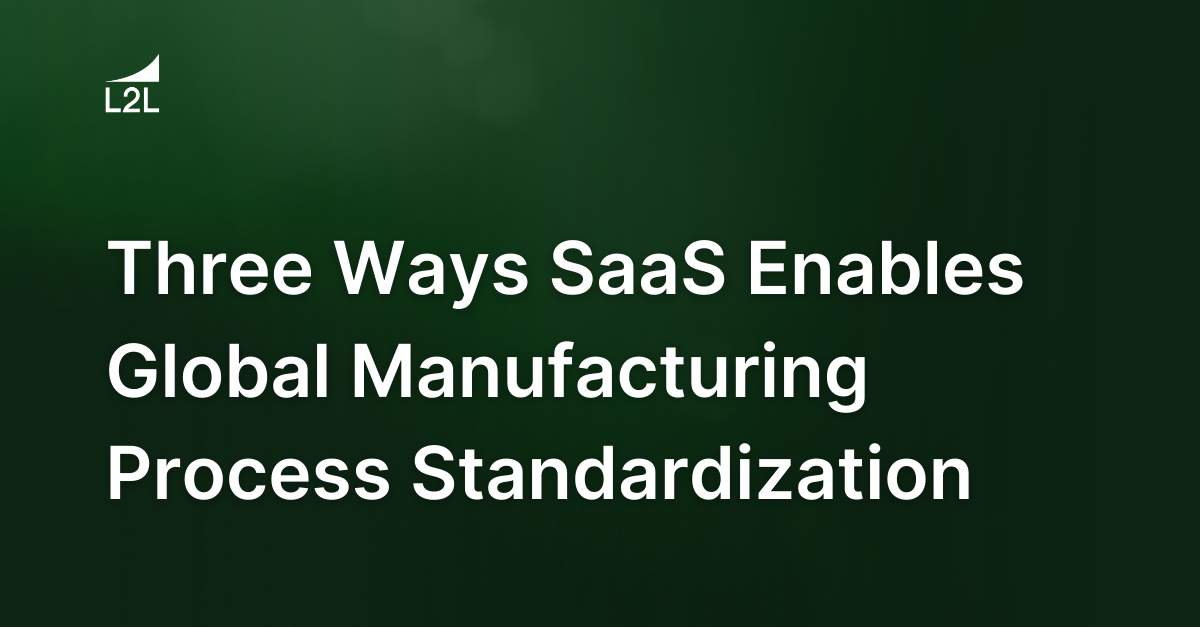
Estimated read time: Five minutes
A global solution for manufacturing process standardization
For companies with factories around the globe, creating standard processes in order to ensure a quality product is an incredibly difficult undertaking.
The number of barriers that stand in the way of manufacturing process standardization is endless. From culture to language to raw material variation, defining a standard that will work with all of these barriers can challenge even the best of organizations.
The sheer effort to understand which processes are being performed better than another's from plant to plant to plant is almost overwhelming. And once a best practice is chosen, organizations must then figure out how to standardize that process in all areas, lines and machines around the world.
However, there have been major strides in technology over the past few years that have all but eliminated these barriers. The advent of connected workforce software, like L2L, along with cloud computing and an influx of mobile devices on the shop floor, have given companies the ability to collect, share and display process information around the world with little to no variation from site to site.
Because these software solutions reside in "The Cloud,” companies now have a platform that is accessed through a web address instead of local, on-premise servers. This global access allows all users within the company to have access to the same information simultaneously.
Let’s explore in more depth, 3 ways that these advancements are enabling global manufacturing process standardization.
#1: Simultaneous access to documents
Having now solved the problem of access to simultaneous information around the globe, software developers could now go to work designing features that would further facilitate the standardization of manufacturing processes.
The first was to simply have a platform where best practices could be captured and reviewed once they were established, creating a centralized document control feature that can be accessed by all users provided the solution.
SaaS based document control allows work standards to be easily documented and shared. The key feature is that a single revision of the document is all that is needed.
For example, when a document is accessed and used in the Americas, that same document can also be accessed and used in Asia. So in this instance, once a standard process is identified and the Standard Work A3 is updated, the new revision now deploys to both sites simultaneously, thus ensuring the organization does not have two separate standards for the same process regardless of geography.
#2: Improving the standard
Once the process was established for documenting a standard that everyone could access, the next issue to be solved was that of improvement.
Giving an organization the ability to identify improvements at one location, then share that improvement of a standard to all locations is a critical aspect of any continuous improvement or company-wide Lean initiative.
Software features needed to be developed that would allow sites and even individual employees to submit suggested improvements or Kaizens to the standard. L2L has accomplished this through the design of two key Lean tools within the connected workforce platform.
One of these lean tools is the real-time submission of a Kaizen by users on the shop floor. Most SaaS applications like L2L do not limit the amount or access of users to the software, each individual in the company has a User I.D.
This access allows anyone on the shop floor to submit an improvement idea to a standard immediately from a kiosk or even a mobile device.
This Kaizen then goes into a centralized management flow where the Kaizen can be evaluated and actions such as work orders and engineering projects can be launched to improve the process.
#3: Sharing manufacturing process standards sideways
Understanding that some process improvements may not lend themselves to blanket changes in the standard and that local skill, budget and products may be the deciding factor for the change to the standard, a process to review all new improvements was needed.
The final key ingredient was the ability to share a new and improved standard with all sites around the world for review. In L2L’s connected workforce software, this feature came in the form of virtual Yokoten.
Yokoten, meaning to share sideways, is the concept that once an improvement is made, it can then be easily shared with other departments, lines and machines. The SaaS model has enabled the creation of features that allow users to share these improvements sideways across all sites around the world.
Once an improvement to the process is documented, sites input their “Yokoten” into the software where it is deposited and labeled as new for all of those sites around the world with similar processes. Then, internally each site establishes a review mechanism to determine if the Yokoten shared with them is applicable to their environment.
Conclusion
Having a standard process is key to ensuring product quality and profitability. Having a process that allows for standards to be established is key to meeting this goal. But what has been lacking until now is the ability to establish these standards corporate-wide instead of only within the four walls of a single facility.
SaaS connected workforce platforms like L2L have come of age through the advent of technology in software design, cloud computing and mobile devices to solve the problems faced by companies to take manufacturing process improvement and standardization worldwide.
To learn more about how you can take a pragmatic approach to global manufacturing process standardization, book a demo today.
Revisions
Original version: 22 February 2022
Written by: Eric Whitley
Reviewed by: Daan Assen
Please read our editorial process for more information
Related Posts
Subscribe to Our Blog
We won't spam you, we promise. Only informative stuff about manufacturing, that's all.



